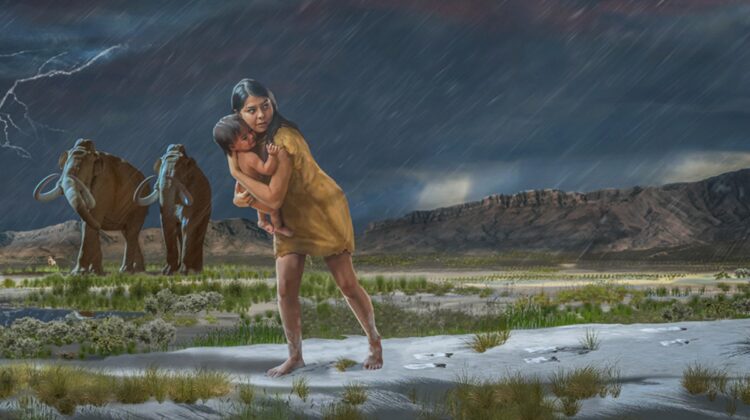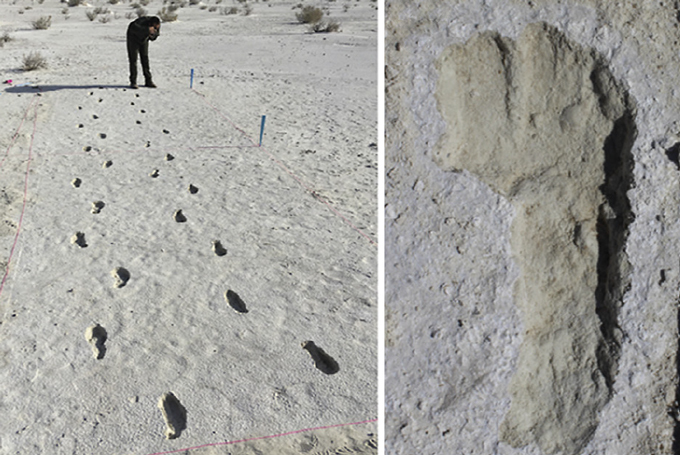
In the heart of New Mexico, amidst the remnants of the Ice Age, lies an extraordinary discovery that unveils the arduous footsteps of our ancient ancestors. Stretching over a staggering distance of 1.5 kilometers, this prehistoric trail is not only the longest ever found but also offers tantalizing insights into a potentially perilous expedition. The footprints etched into time reveal the hurried passage of a young adult or teenager carrying a toddler, shedding light on a captivating narrative from the depths of the past.
In the captivating landscape of what is now White Sands National Park, an individual forged their path across a muddy expanse, surrounded by mammoths and colossal ground sloths. Today, over 10,000 years later, the fossilized footprints left behind bear witness to this momentous journey. Discovered by chance in 2018 along the ancient shore of Lake Otero, now long gone, the continuous trail of dark spots intrigued scientists who embarked on a meticulous excavation to unravel its secrets.

Among the 427 human footprints found, researchers focused their analysis on 90 of them. The size and depth of the impressions indicated that a young woman or teen was responsible for their creation. Uneven and slippery imprints hinted at the challenging terrain, while the presence of smaller footprints beside the larger ones indicated that the burden carried during the journey was none other than a young child, approximately three years of age. The connection between the adult’s hurried steps and the presence of the child evokes a timeless sense of compassion and urgency that resonates with our own experiences as caretakers.
The significance of this prehistoric trail extends beyond its length. It offers a glimpse into the behavior and resilience of our ancient kin, granting a personal connection to the past that few discoveries can match. As we imagine the challenges faced by the young adult, carrying a child on their back, a sense of empathy arises, reminding us of the shared human experiences that transcend time.

The circumstances surrounding this journey remain shrouded in mystery. The individual’s haste suggests a sense of urgency, although the reasons behind it elude us. Fatigue may have plagued the traveler, yet determination spurred them onward, refusing to yield. In this remarkable tale from the past, we find echoes of our own struggles and the perseverance that defines us as a species.
The perils of this ancient expedition become apparent when we consider the presence of other footprints intersecting with those of the humans. The imprints of mammoths and ground sloths entwined with the human tracks paint a vivid picture of a land where humans and formidable creatures coexisted. While the mammoths seemed oblivious to the human presence, the giant ground sloth, standing tall on its hind legs, circled cautiously, sensing the proximity of a human. This interaction suggests that such encounters between humans and prehistoric animals were not uncommon, underscoring the dynamic nature of the Ice Age world.

Dating the footprints to the late Ice Age, researchers have uncovered a precious link to a bygone era. It is a connection that surpasses the boundaries of time, offering us a window into the lives of our ancient ancestors. The longest prehistoric human trail ever discovered stands as a testament to human resilience and adaptability in the face of challenging environments and formidable creatures.
As we marvel at the footsteps left behind by these intrepid travelers, we are reminded of our shared heritage and the timeless narratives etched into the Earth’s surface. The enigmatic journey captured in these fossilized footprints sparks our imagination and fuels our curiosity, urging us to unravel the mysteries of our past and discover the profound stories that await us beneath the layers of time.

Leave a Reply